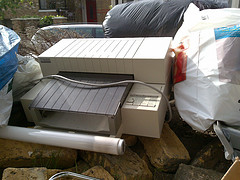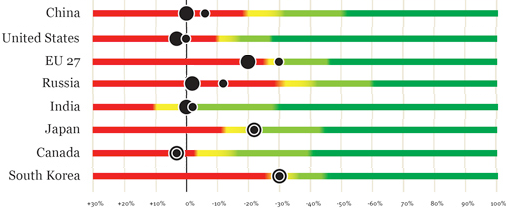Last week I wrote about the post-COP15 emissions target deadline that whizzed by for most of the planet, and tried to put it into context. Of course, the larger question of what the resulting cuts would mean with regards to future warming remained unanswered, due to it being written during the wee hours of the morning. Fortunately, someone else also crunched the numbers and compared them to model predictions, New Scientist reports, arriving at a most unfortunate (but unsurprising) answer.
Electronics Recycling II
 Sarah previously wrote about safe and ethical electronics recycling, and we follow up today with a little information about additional options.
Sarah previously wrote about safe and ethical electronics recycling, and we follow up today with a little information about additional options.
Office supply stores like Staples often have recycling programs1 for computers and peripherals, including cash back for ink and toner cartridges if you prefer not to bring them to a local refill business like InkTec Zone or Cartridge World franchise.
Staples is also offering $50 trade-in rebates on old printers through April 3. If you do opt for a new printer, be sure to look at reviews and specifications regarding durability, ink frugality, and power consumption.
1. The equipment is picked up and delivered to our recycling partner, Eco International, who disassembles the equipment into its component parts for environmentally responsible recycling in the U.S. (Staples Recycling FAQ)
Initial information provided by “k / total recycling”
Site Notes
Your humble editors would like to expand the number and variety of voices on Warm Home Cool Planet by extending an offer to our readership seeking additional local contributors. Although we can only offer a modicum of glory, it can be interesting and rewarding to share news and views with others. If you’re interested but not sure what to write about, please do not let this dissuade you, we maintain a fresh spool of topic prompts. Do you already publish an environmentally themed blog? We would be happy to syndicate or ‘cross-post’ select articles. For more information about contributing please contact us.
P.S. In addition to the new streaming calendar in the header above, we also recently added a voting system to the site. If you could, please take a moment to vote on posts after reading them. This feedback can help encourage authors, and also inform us of the sort of topics you are interested in reading about.
Déjà vu?
It appears the Obama Administration is starting to eerily resemble the Bush Administration, at least when it comes to energy policy. In last week’s State of the Union address, President Obama touched on—albeit briefly—clean energy standards and climate change. Sadly, those “standards” reflected the days of recent past: investing in “clean coal” technology, nuclear power and biofuels. As for significant wind and solar power investment? Hmmm…
To make matters more dire, the Obama EPA has signed off on the Renewable Fuel Standard established under the Bush administration. The Renewable Fuel Standard supports energy-intensive corn production for ethanol, which is high in GHG as well as inefficient to produce. The EPA is also apparently in support of Carbon Capture and Storage technology which is said to reduce the amount of CO2 leaked into the atmosphere from coal-fired power plants. What about the damaging coal extraction process that leaves mountaintops bare, rivers polluted and coal ash? And nuclear energy? Never mind the issue of waste, the sheer number of new nuclear power plants that would have to be constructed to account for our ever-growing demand for energy is daunting in itself.
So where does this leave us? Hopefully Obama will understand that investing in truly clean sources of renewable energy, like wind and solar, is not only good for the environment, but good for our struggling economy. Instead of investing in “clean coal” technology, let’s instead subsidize clean energy center training and education programs so coal miners can gain marketable skills in a safer, cleaner industry. Instead of a short term approach, let’s mix that with a long term agenda so we can, in time, ween off of the fossil fuel based economy we’ve grown so accustomed to and onto a green, renewable one. If the U.S. wants to “lead” in the global clean energy race, at this point, there really is no time left to waste.
Cambridge to host 3rd Climate Congress
 A third Climate Congress will be held on Saturday, March 6, 2010, from 9am to noon, in City Hall. The Climate Congress is open to the public. The main aim will be for delegates to unite on specific recommendations for City action. The Congress will use the opportunity to decide on whether to accept a final report on proposals and to bring the new citizen action teams together.
A third Climate Congress will be held on Saturday, March 6, 2010, from 9am to noon, in City Hall. The Climate Congress is open to the public. The main aim will be for delegates to unite on specific recommendations for City action. The Congress will use the opportunity to decide on whether to accept a final report on proposals and to bring the new citizen action teams together.
During the second Climate Congress, 75 delegates convened to develop recommendations to the city for addressing climate change, but also organize and develop citizen generated solutions. Highlights from the second congress include:
- The Congress discussed priorities among the proposals in the Draft Report. Several common themes emerged and these will be documented in the final report of the Congress.
- Delegates formed action teams to work in specific areas: outreach, resilience, solar and other renewables, process for future climate emergency response (drafting), protection of trees and natural resources, building efficiency, and measurement . Several of these groups have already agreed to meet again. (If you are interested in participating in any of these groups contact Joanna Herlihy <joanna_herlihy@yahoo.com>)
- Recommendations for climate emergency response by the City were considered and received broad support. However, there were questions about the specifics and report structure, that required more time to consider. Those present unanimously agreed to meet again for a third session to address those questions.
For more information about the climate emergency and the Climate Congress visit: http://www.cambridgema.gov/deptann.cfm?story_id=2457&pv=Yes
55 countries down…?
 There’s a lot of press today about the fact that 55 countries have submitted emissions reduction pledges to the U.N. as the deadline drew passed; note that 27 of them are in the EU. New Scientist has a nice summary, and Reuters India lists most of the targets.
There’s a lot of press today about the fact that 55 countries have submitted emissions reduction pledges to the U.N. as the deadline drew passed; note that 27 of them are in the EU. New Scientist has a nice summary, and Reuters India lists most of the targets.
Some of the more disappointing targets include our own, our neighbors to the north, and Korea. “The US previously pledged a cut of 17% from 2005 levels by 2020 (equivalent to 3% from the conventional baseline of 1990)” (BBC). True to its word, the increasingly conservative Canadian government submitted the same relative target as the U.S. South Korea—whose emissions have more than doubled since 1990—has committed to an even smaller cut of 4% of 2005 levels. However, it has tries to play up the significance of these cuts by calling them a 30% cut from business as usual.
Below you can find a summary of the pledges of the top eight emitters (78%) of carbon dioxide, and what their effect might be. Please note that barring an international agreement in Mexico next winter, China and India’s targets are even less firm than those of other nations since they have vowed to decrease intensity (increase efficiency) by 40-45% & 16-20% respectively, rather than make cuts towards a specific target. These estimates are therefore a best case scenario under the unlikely condition of zero future growth.
| Baseline | 2007 | % Global | Cut | 2020 | |||
|---|---|---|---|---|---|---|---|
| MT CO2 | Year | MT CO2 | MT CO2 | ||||
| 1 | China | 6083.0 | 2007 | 6083.0 | 27.57% | 40.00% | 3649.8 |
| 2 | U.S. | 5857.1 | 2005 | 5853.5 | 26.53% | 17.00% | 4861.4 |
| E.U. | 4135.4 | 1990 | 3971.1 | 18.00% | 20.00% | 3308.3 | |
| 3 | Russia | 2302.6 | 1990 | 1579.0 | 7.16% | 20.00% | 1842.1 |
| 4 | India | 1369.9 | 2007 | 1369.9 | 6.21% | 16.00% | 1150.7 |
| 5 | Japan | 1069.4 | 1990 | 1235.1 | 5.60% | 25.00% | 802.1 |
| 8 | Canada | 543.4 | 2005 | 540.8 | 2.45% | 17.00% | 451.0 |
| 9 | South Korea | 361.4 | 2005 | 499.0 | 2.26% | 4.00% | 346.9 |
| World | 2007 | 29320.0 | 16.09% | 24600.9 | |||
MT = megatonne. approximately 2.2 billion pounds.
Countries 7 & 8 are the United Kingdom and Germany, both members of the European Union.
Sources: Emissions data, and pledges from stories linked in this post.
Ecosystem foot cubed
 National Geographic has an interesting article about “the amount of life you can find in one cubic foot” of various ecosystems around the world. The article itself is short on details about the method, but beautifully written. For a description of the process watch the attached videos. Hint: It’s not an instantaneous cubic foot.
National Geographic has an interesting article about “the amount of life you can find in one cubic foot” of various ecosystems around the world. The article itself is short on details about the method, but beautifully written. For a description of the process watch the attached videos. Hint: It’s not an instantaneous cubic foot.
Environmental pawprints
Lest our dog-owning readers think that the above comic unfairly singles out their pooches, note that the original research it is commenting upon is not limited to canines. It turns out that a variety of pets have numerous, oft-overlooked consequences for the environment, be it illegal bird and fish trafficking, or the insistence that Fluffy should eat better than her owner. The latter is a rather disturbing and unnatural trend since undomesticated Felis and Canis eat as much of their prey as they can, offal and all. Indeed, one of the major impacts of free ranging cats is songbird predation.
Water pollution is another unfortunate side-effect of pets. Pooper-scooper laws are not just about aesthetics and clean shoes, but public and environmental health. Besides carrying a variety of pathogens, Spot’s spots are essentially fertilizer and can contribute to algal blooms and fish kills if they make it into water ways. It is especially important to clean up after your dog—and there are free baggie dispensers in case you forget to grab some on your way out—if you bring him to Fresh Pond, since this beautiful water body is an important wildlife habitat and a part of our water supply. Cat waste can also contribute to water pollution. Flushable litter has lead to the decline of Californian sea otters, and it can infect other wildlife as well e.g; filter-feeders such as oysters and clams. Other choices of litter are also problematic, although a variety of less harmful options are available.
None of this is to say that you should not have a pet, or dissuade you from pets in the future, but merely to add to the list of things you should consider before doing so besides whether or not you have the necessary time to devote to the pet’s care and convincing your landlord/partner to allow it.
- Adopt rather than buy, and if you’re leaning towards exotics be sure to purchase from a reputable dealer.
- Always spay or neuter.
- Keep Fluffy indoors, and clean up after Spot.
- Although Fluffy (arguably) cannot survive on bread alone, neither she nor Spot needs filet mingon or Patagonia toothfish
- If you keep fish, be careful with your aquarium plants to avoid contributing to the spread of invasive species such as Caulerpa taxifolia
New Commonwealth Solar Programs available Today!
 The Commonwealth Solar Stimulus and Commonwealth Solar Rebate Programs will be available today at 2:00 PM EST on Wednesday, January 27, 2010.
The Commonwealth Solar Stimulus and Commonwealth Solar Rebate Programs will be available today at 2:00 PM EST on Wednesday, January 27, 2010.
The Commonwealth Solar Program provides rebates through a non-competitive application process for the installation of photovoltaic (PV) projects. The Commonwealth Solar II Rebate Program provides rebates for commercial systems up to 5 kilowatts (kW) and all residential systems (regardless of size). The Commonwealth Solar Stimulus Rebate Program provides rebates for commercial PV systems sized greater than 5 kW up to 200 kW.
The Commonwealth Solar program issued awards for the installation of 23.5 megawatts (MW) of solar power over the last two years, but recently ran short of funding. The new rebate programs for homeowners, business, and communities throughout the Commonwealth will help the commonwealth reach Governor Deval Patrick’s goal of installing 250 MW of solar energy by 2017. Commonwealth solar also provides webinars and information on helpful resources, plus view the map of installations of solar photovoltaic projects across the state.
Report on Second Climate Congress
by congress planning committee member Joanna Herlihy:
 The second session of the Climate Emergency congress was even livelier that the first. Delegates found that prioritization of their recommendations had not progressed much beyond the ‘laundry list’ categorization of the ‘Draft Recommendations’ issued a few weeks earlier. Apparently this was partly due to technical and organization problems with incorporating responses to the online survey, most of which came in during the last few days.
The second session of the Climate Emergency congress was even livelier that the first. Delegates found that prioritization of their recommendations had not progressed much beyond the ‘laundry list’ categorization of the ‘Draft Recommendations’ issued a few weeks earlier. Apparently this was partly due to technical and organization problems with incorporating responses to the online survey, most of which came in during the last few days.
The version of the recommendations presented to the second session included a new proposal advanced by the drafting group to encapsulate suggestions to set up provisions for ensuring citizen participation in and adequate city staffing for follow-up on the recommendations.
The next breakout into small groups was self-organized by delegates according to ‘open space’ principles, grouping according to areas of interest, which resulted in several potential task forces that intend to continue working in the areas of environmental justice, education, building energy efficiency, and urban forestry. Discussions on goal-setting and how best to coordinate city-community initiatives would have been useful but did not occur.
The finale, which extended an hour overtime, focused on whether the congress should endorse some broad principles or recommend formation of a City Manager-appointed committee of citizens to promote and coordinate response to the climate emergency. In the general discussion, observations ranged from “the city already has such a committee with almost the same mission” (Climate Protection Action Committee) to “such citizen groups function better independently of the city government”.
The facilitator’s suggestion that the option of a citizen committee be voted on without specifying who would appoint it was rejected. An intriguing new suggestion was advanced during the discussion: add authority over a ‘carbon budget’ to the duties of the city council-appointed City Auditor. The congress finally agreed to reconvene for a third session, probably in March, to vote on some well organized recommendations in printed form to strengthen local climate protection efforts.



